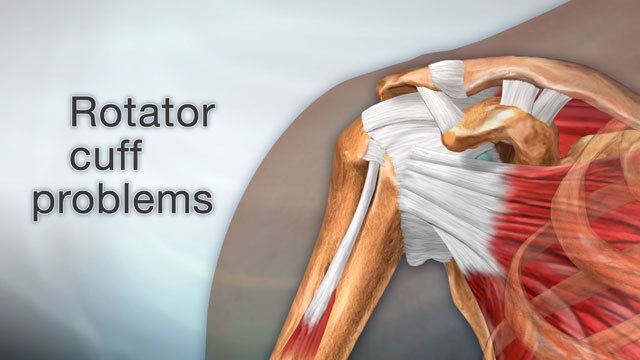Rotator cuff - self-care
The rotator cuff is a group of muscles and tendons that attach to the bones of the shoulder joint, allowing the shoulder to move in a coordinated and pain-free way and remain stable. The tendons can be torn from overuse, injury, or wearing away over time.
Pain relief measures, using the shoulder properly, and shoulder exercises may help ease your symptoms.

Common rotator cuff problems include:
- Tendinitis, which is inflammation of the tendons and swelling of the bursa (a normally smooth layer) lining these tendons
- A tear, which occurs when one of the tendons is torn from overuse or injury
Relieving the Pain
Medicines, such as ibuprofen or naproxen, may help reduce swelling and pain. If you take these medicines every day, tell your health care provider so that your general health can be monitored.
Moist heat, such as a hot bath, shower, or a heat pack, can help loosen up your shoulder when you feel pain in your shoulder. An ice pack applied to the shoulder 20 minutes at a time, 3 to 4 times a day, may also help cut down the swelling when you are in pain. Wrap the ice pack in a clean towel or cloth. Do not place it directly on the shoulder. Doing so may cause frostbite.
Using Your Shoulder
Learn how to care for your shoulder to avoid placing extra stress on it. This can help you heal from an injury and avoid re-injury.
Your positions and posture during the day and night can also help relieve some of your shoulder pain:
- When you sleep, lie either on the side that is not in pain or on your back. Resting your painful shoulder on a couple of pillows may help.
- When sitting, use good posture. Keep your head over your shoulder and place a towel or pillow behind your lower back. Keep your feet either flat on the floor or up on a footstool.
- Practice good posture in general to keep your shoulder blade and joint in their ideal positions.
Other tips for taking care of your shoulder include:
- Do not carry a backpack or purse over just one shoulder.
- Do not work with your arms above shoulder level for a long time. If needed, use a foot stool or ladder.
- Lift and carry objects close to your body. Try not to lift heavy loads away from your body or overhead.
- Take regular breaks from any activity you do over and over again.
- When reaching for something with your arm, your thumb should be pointing up.
- Store items you use every day in places you can reach easily.
- Keep things that you use a lot, such as your phone, with you or close by to avoid reaching and re-injuring your shoulder.
Physical Therapy and Exercises
Your provider will likely refer you to a physical therapist to learn exercises for your shoulder.
- You may start with passive exercises. These are exercises the therapist will do with your arm. Or, you can use your good arm to move the injured arm. The exercises may help get the full movement back in your shoulder.
- After that, you will do exercises the therapist teaches you to strengthen your shoulder muscles.
- Most of the exercises may focus on your shoulder blade and improvements with shoulder movement.
Returning to Sports
It is best to avoid playing sports until you have no pain during rest or activity. Also, when examined by your provider or physical therapist, before returning to sports, you should have:
- Full strength in the muscles around your shoulder joint
- Good range of motion of your shoulder blade and upper spine
- No pain during certain physical exam tests that are meant to provoke pain in someone who has rotator cuff problems
- No abnormal movement of your shoulder joint and shoulder blade
Returning to sports and other activities should be gradual. Ask your physical therapist about the proper technique you should use when doing your sports or other activities that involve a lot of shoulder movement.
References
Finnoff JT, Johnson W. Upper limb pain and dysfunction. In: Cifu DX, ed. Braddom's Physical Medicine and Rehabilitation. 6th ed. Philadelphia, PA: Elsevier; 2021:chap 35.
Mosich GM, Yamaguchi KT, Petrigliano FA. Rotator cuff and impingement lesions. In: Miller MD, Thompson SR, eds. DeLee, Drez, & Miller's Orthopaedic Sports Medicine. 5th ed. Philadelphia, PA: Elsevier; 2020:chap 47.
Review Date: 4/24/2023





